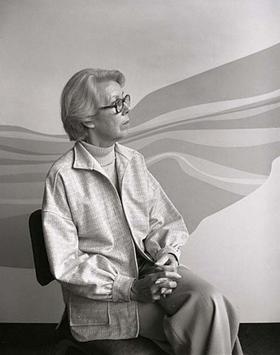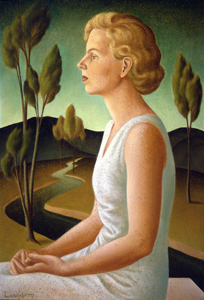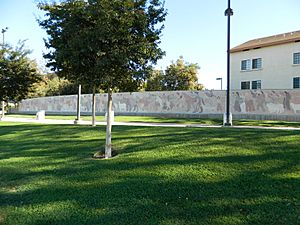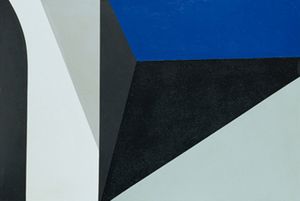Helen Lundeberg facts for kids
Helen Lundeberg (1908–1999) was an important American painter from Southern California. She is known for helping to start the Post-Surrealist art movement. She did this alongside her husband, Lorser Feitelson.
Helen's art style changed a lot during her career. She explored different ways of painting. Her work is often described as Post-Surrealism, Hard-edge painting, and Subjective Classicism.
Contents
Early Life and Learning
Helen Lundeberg was born in Chicago on June 24, 1908. Her parents were from Sweden. In 1912, her family moved to Pasadena, California.
As a child, Helen was very smart. She loved to read and was an amazing student. Because she was so bright, she was chosen for a special study. This was a Stanford University project called "Study of Gifted Children." It looked at kids who were in the top 1% of students in California. When she was young, Helen first wanted to be a writer.
Later, she started painting. She made portraits of herself, her mother, and her sister.
Becoming an Artist
In 1930, Helen Lundeberg finished Pasadena Junior College. She then took art classes at the Stickney Memorial Art School in Pasadena. There, she met her teacher, Lorser Feitelson, who was also a painter.
Feitelson's energetic teaching style really inspired Helen. He had wide interests in art from all over the world. Helen once said that when Lorser explained things, "light dawned!" She found it very exciting.
In the 1930s, Helen worked in two styles. These were social realist and Post-Surrealist. Her first art show was in 1931 in San Diego. She showed her painting called Apple Harvesters. In 1933, she had her first solo show in Los Angeles. She and Lorser Feitelson got married that same year.
Starting Post-Surrealism
In 1934, Helen and Lorser started an art movement. They called it Subjective Classicism, or New Classicism. It later became known as Post Surrealism. Helen wrote a special statement about this new style. She used her painting Plant and Animal Analogies as an example.
Post Surrealism was the first big art movement in the US that responded to European Surrealism. European Surrealists often used random dream images. But American Post-Surrealists like Helen were different. They carefully planned their subjects. Their goal was to guide the viewer through the painting. This helped to slowly reveal a deeper meaning. This way of working fit Helen's smart and thoughtful personality. Her connection to surrealism stayed in her art for many years.
Working for the WPA
From 1936 to 1942, Helen worked for the Works Progress Administration (WPA). This was a government program during the Great Depression. For the WPA, she made lithographs, paintings, and murals. These were all around the Los Angeles area.
Helen painted a series of three large murals for the Bob Hope Patriotic Hall. These were called Preamble to the Constitution, Free Assembly, and Free Ballot. She used oil paint and had four assistants. Sadly, these murals were taken down in the 1970s and are now lost. Another artist, Kent Twitchell, later created new murals for the hall. He based them on Helen's lost works.
In 1941, the WPA asked Helen to paint a mural at the Fullerton City Hall. This building is now the Fullerton Police Department. Helen's mural, History of California, covered three walls. It showed scenes from California's past. These ranged from Spanish explorers arriving to the rise of Hollywood. When the building became a police station, the mural was painted over. It stayed covered until it was restored in 1993.
Helen also completed a mural called History of Transportation. This was for the WPA near Edward Vincent, Jr. Park in Inglewood, California. This mural is 8 feet (2.4 m) tall and 241 feet (73 m) long. It is made of a special material called petrachrome. The mural shows the history of transportation in the Centinela Valley. It includes people using carriages, steam trains, cars, and airplanes. After many years of damage, the mural was fixed in 2007. It was moved to its current spot across from Inglewood High School. The first drawings for this mural are kept at the Nevada Museum of Art.
Helen's work for the WPA in Southern California was very important. Her art was well-liked. Also, she was one of only three women artists in Southern California who made public art for the WPA.
Changing Art Styles
Moving to Abstraction
In the 1950s, Helen's art changed again. She started painting in a style called geometric abstraction and Hard Edge painting. This was different from her earlier, more realistic work. Her paintings were still based on real things. But she created mysterious images that were a mix of abstract and recognizable shapes.
Helen's paintings from this time are often called formal and lyrical. They use very exact designs and limited colors. These paintings also explored the idea of "mood entity." This was a Post-Surrealism idea about showing feelings and moods in each artwork. Helen and Feitelson were part of a group of Post-Surrealists. This group included artists like Grace Clements and Philip Guston. During this time, Helen was one of the busiest painters in Southern California.
In the 1960s and 1970s, Helen kept exploring abstract art. She painted landscapes, indoor scenes, still life, and planets. She often painted the same ideas with different colors. In the 1980s, she made paintings that showed landscapes and buildings. Her love for 15th-century Italian Classicist painters can be seen in many of these works.
Helen Lundeberg painted for over 60 years. She always put her own unique ideas and careful use of color into her art. Her last known painting, Two Mountains, was made in 1990. Helen Lundeberg passed away in 1999 at the age of 91.
Achievements and Exhibitions
Helen was a very talented child. In high school, she was chosen for a special study. This study was led by Dr. Lewis Terman from Stanford University.
In 1949, Helen won an award for her painting The Clouds. This was at an art exhibition in California. In 1950, she won another award for her painting Spring. This was at the Los Angeles County Museum.
Helen Lundeberg's paintings have been shown in many famous museums. These include:
- The J. Paul Getty Museum in Los Angeles
- The Whitney Museum of American Art in New York
- The San Francisco Museum of Modern Art
- The Brooklyn Museum
- The Los Angeles County Museum of Art
- The National Museum of American Art in Washington D.C.
Her work was recently part of two big exhibitions. One was at the J. Paul Getty Museum. The other was at the Los Angeles County Museum of Art.
The American band, Sonic Youth, has a song called "Helen Lundeberg." It is on their 2006 album Rather Ripped. The song's lyrics list the names of Helen's paintings. These paintings were shown in her exhibition called Illusory Landscape.





